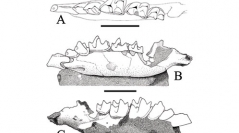

 Comptes Rendus Palevol
18 (3) - Pages 317-324
Comptes Rendus Palevol
18 (3) - Pages 317-324Terrestrial vertebrates from the karst filling in Cap d’Artrutx, situated in the extreme Southwest of Menorca (Balearic Islands, western Mediterranean) have yielded interestinginformation on the migration and extinction dynamics in the terrestrial island vertebrate faunas in Mallorca and Menorca between the late Pliocene and early Pleistocene. In this site,remains of the Menorcan giant tortoise (“Testudo” gymnesica Bate, 1914) and two mammals (Nesiotites sp. and Hypnomys sp.) have been found. The remains of the Menorcan giant tor-toise represent the youngest record of this species and of the so-called second faunistic group of the island. The morphology and size of Nesiotites sp. are comparable to those of Nesiotites aff. ponsi Reumer, 1979 from the Plio-Pleistocene of Pedrera de S’Ònix (Mallorca) and Nesiotites meloussae Pons and Moyà, 1980 (= Nesiotites aff. ponsi sensu Pons-Monjo et al., 2012) from the lower Pleistocene of Binigaus (Menorca). Hypnomys sp. can belong toan archaic species not yet described. They represent the first evidence of the entrance ofthe third faunistic group, which originally evolved on the neighbouring island of Mallorca.This association is interpreted, therefore, as the first evidence of a faunal succession in the Plio-Pleistocene in the Balearic Islands.
Palaeokarst filling, second and third faunistical groups, Minorcan giant tortoise, migration and extinction, climatic changes